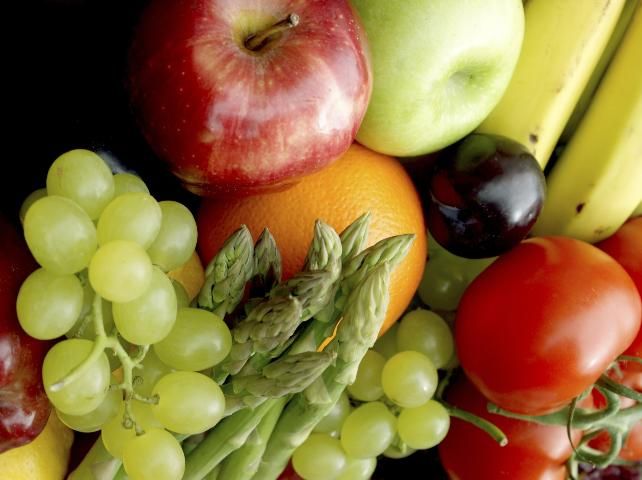What is fructose?
Fructose is a simple sugar found in many foods. Common table sugar is made of equal amounts of fructose and glucose. Similarly, high-fructose corn syrup (HFCS), commonly used to sweeten foods, contains a mixture of fructose and glucose. Fructose is sweeter than glucose, so it has been used in many sweetened foods (Lê and Tappy 2006).
What foods contain fructose?
Fructose occurs naturally in honey as well as in small quantities in many fruits and vegetables. However, these foods also contain other sugars, such as glucose. Table 1 lists foods with naturally occurring fructose (USDA and USDHHS 2020).

Credit: Ingram Publishing
Fructose, in the form of HFCS, is added to many processed foods, such as carbonated beverages, baked goods, canned fruits, and jellies. Other fructose-containing sweeteners include white sugar, brown sugar, corn syrup, raw syrup, and molasses.
How much fructose is recommended?
There are no specific recommendations for fructose intake. The USDA recommends limiting the intake of foods that contain added sugar, including fructose (USDA and USDHHS 2020). The USDA guidelines do not distinguish between sucrose (table sugar) and HFCS as added sugar sources. Added sugars contribute about 13% of the total energy (calories) in American diets, exceeding the recommendation of less than 10%. The major food sources of added sugars are soft drinks, fruit-flavored drinks, sports drinks, snacks, and sweets.
Intake of foods with added sugars should be limited because they provide calories and often have little other nutritional value. They generally provide low amounts of vitamins, minerals, or protein to aid in maintaining a balanced diet (USDA and USDHHS 2020).
How is HFCS made?
HFCS has become very popular with food companies because of its stability, ease of use, and sweetness. HFCS is produced by wet milling corn to separate starch from protein, oil, and fiber. The starch then undergoes several processing steps to produce the HFCS (Ramírez et al. 2009), which contains either 55% or 42% fructose, with the balance mainly glucose and a few percent of other sugars (Hanover and White 1993).
Is it safe to consume fructose?
Intakes of fructose in the US have increased in the last 40 years, mostly due to sugar-sweetened beverages (Vos et al. 2008), although the amount of fructose in the food supply has not seemed to change (Carden and Carr 2013). Although it has been suggested that consuming fructose has health risks, moderate intakes of added sugars, including fructose, do not seem to increase risk of obesity, diabetes, or cardiovascular disease (Rippe and Angelopoulos 2016). Fructose has similar effects on blood lipids (e.g., LDL cholesterol and triglycerides) as other carbohydrates (Chiavaroli et al. 2015), and fructose intake is not associated with an increased risk of hypertension (high blood pressure) (Jayalath et al. 2014). Moderation is the key to health, and limiting sugar-sweetened beverages and other foods that contain added sugars is recommended (USDA and USDHHS 2020).
Should we avoid HFCS?
The use of HFCS in the US has decreased (USDA 2013). The average person consumes more than 50 pounds of HFCS per year (USDA 2012), much of which is from sweetened beverages (Bray, Samara, and Popkin 2004). The abundance of HFCS in the food supply makes it difficult to choose foods that do not contain HFCS. Avoidance is likely not necessary for good health. Choosing naturally occurring foods with fructose, such as fruits and vegetables, while limiting sugar-sweetened beverages and foods, is a step toward optimum health (USDA and USDHHS 2020).
References
Bray, G. A., J. N. Samara, and B. M. Popkin. 2004. "Consumption of High-Fructose Corn Syrup in Beverages May Play a Role in the Epidemic of Obesity." Am J Clin Nutr. 79: 537–543.
Carden, T. J., and T. P. Carr. 2013. "Food availability of glucose and fat, but not fructose, increased in the U.S. between 1970 and 2009: analysis of the USDA food availability data system." Nutr J 12:130. doi: 10.1186/1475-2891-12-130.
Chiavaroli, L., R. J. de Souza, V. Ha, A. I. Cozma, A. Mirrahimi, D. D. Wang, et al. 2015. "Effect of Fructose on Established Lipid Targets: A Systematic Review and Meta-Analysis of Controlled Feeding Trials." J Am Heart Assoc 4 (9):e001700. doi: 10.1161/jaha.114.001700.
Hanover, L. M., and J. S. White. 1993. "Manufacturing, Composition, and Applications of Fructose." Am J Clin Nutr. 58: 724S–732S.
Jayalath, V. H., J. L. Sievenpiper, R. J. de Souza, V. Ha, A. Mirrahimi, I. D. Santaren, S. Blanco Mejia, et al. 2014. "Total fructose intake and risk of hypertension: a systematic review and meta-analysis of prospective cohorts." J Am Coll Nutr 33 (4):328-39. doi: 10.1080/07315724.2014.916237.
Lê, K. A, and L. Tappy. 2006. "Metabolic Effects of Fructose." Curr Opin Clin Nutr Metab Care 9: 469–75.
Ramírez, E. C., D. B. Johnston, A. J. McAloon, and V. Singh. 2009. "Enzymatic Corn Wet Milling: Engineering Process and Cost Model." Biotechnol Biofuels 21:2.
Rippe, J. M., and T. J. Angelopoulos. 2016. "Added sugars and risk factors for obesity, diabetes and heart disease." Int J Obes (Lond) 40 Suppl 1:S22-7. doi: 10.1038/ijo.2016.10.
United States Department of Agriculture (USDA). 2012. Economic Research Service. "Food Availability (Per Capita) Data System." http://www.ers.usda.gov/data/foodconsumption.
United States Department of Agriculture (USDA). 2013. Economic Research Service. "Sugar and Sweeteners Yearbook Tables. Corn Sweetener Supply, Use, and Trade." http://www.ers.usda.gov/data-products/sugar-and-sweeteners-yearbook-tables.aspx#25480.
USDA (United States Department of Agriculture). 2015. Agricultural Research Service. "Nutrient Data Laboratory Home Page." http://www.ars.usda.gov/ba/bhnrc/ndl.
U.S. Department of Agriculture and U.S. Department of Health and Human Services. Dietary Guidelines for Americans, 2020-2025. 9th Edition. December 2020. Available at DietaryGuidelines.gov.
Vos, M. B., J. E. Kimmons, C. Gillespie, J. Welsh, and H. M. Blanck. 2008. "Dietary fructose consumption among US children and adults: the Third National Health and Nutrition Examination Survey." Medscape J Med 10 (7):160.